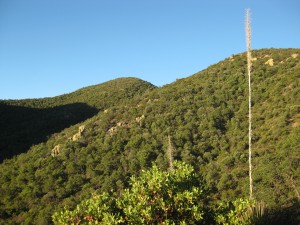Identified: 5/2014
Size: 28 square miles, 18120 acres.
Site Stewards: Patagonia Area Resource Alliance (PARA).
Visiting the IBA: From Tucson: Go east on I-10 and take exit 281 to Highway 83. Go 25 miles south on Highway 83 to the junction of Highway 82 and 83 in Sonoita, go left (heading west) and go 12 miles to the town of Patagonia, watch those speed limits entering town. As you enter Patagonia the town park is on your left, make a left and then another left and head northeast on McKeown Ave, keep going and this becomes Harshaw Road and heads into the Patagonia Mountains. Birding is good all along the road and many of the side roads (marked with brown Forest Service numbered signs) are suitable for walking. To return, simply turn around and drive back to Patagonia.
 Ownership: Coronado National Forest and Private (permission only).
Ownership: Coronado National Forest and Private (permission only).
Site Description: The Patagonia Mountains generally support an extensive oak-juniper biome along with many canyons and drainages lined with sycamores and other riparian vegetation. As you move higher in elevation, the vegetation becomes more oak-pine and pine oak dominated. These mountains exhibit “sky island” properties of a high elevation area (in this case primarily oak and oak-juniper) surrounded by grasslands and desert. There are also some private properties and ranches dotted throughout the National Forest land.
Birds: The Patagonia Mountains provide habitat for Madrean Occidental “Sky Island” breeding and resident birds as well as acting as an important stopover point for migrants. The extensive oak habitat of this IBA distinguishes it from other nearby Sky Islands that usually contain a limited band of oak habitat before transitioning into different, higher elevation habitat. This large oak habitat with mico-habitats of drainages and rocky slopes make this an excellent habitat for many species. From May 2009 to October 2013, the IBA survey teams found 115 species of birds in the Patagonia Mountains. Of those, 18 are special conservation status species found in significant numbers, which qualifies this site under the Arizona IBA criterion, Site Important to Special Status Avian Species.
Year-round: Eastern “Azure” Bluebird, Montezuma Quail, Rufous-crowned Sparrow, Arizona Woodpecker, Canyon Towhee, “Gould’s” Wild Turkey.
Breeding: Elegant Trogon, western Yellow-billed Cuckoo, Gray Hawk, Northern “Apache” Goshawk, Peregrine Falcon, Mexican Spotted Owl, Whiskered Screech-Owl, Elf Owl, Mexican Whip-poor-will, Common Nighthawk, Olive Warbler, Lucy’s Warbler, Black-throated Gray Warbler, Dusky-capped Flycatcher, Sulphur-bellied Flycatcher, Virginia’s Warbler, Grace’s Warbler.
Migration: Anna’s, Black-chinned and Rufous Hummingbirds; Lazuli Buntings, Painted Buntings, Western Tanagers, MacGillivray’s Warbler Lesser Goldfinches and others.
Maps of the Important Bird Area:
For an interactive map and habitat and land ownership analysis of this IBA visit the National Audubon IBA Map and select “Arizona” and then the name of this Important Bird Area. To access analysis graphs, click on the map boundary of the IBA.
Location: 31.431238324418, -110.730433071274
County: Santa Cruz
Site Status: Identified in May 2014.
Ownership: Coronado National Forest and Private
Area: 28 square miles, 18120 acres.
Criteria:
D1 Site Important to Special Status Avian Species
D3 Rare, Unique, or Exceptional Representative Habitat/Ecological Community – Madrean Occidental Sky Island
Conservation issues:
One of the largest threats to the “sky island” of the Patagonia Mountains is mining. Mining has historically occurred in the Patagonia Mountains and now there is at least one proposed mine being negotiated with the Forest Service. The “Wildcat Mine” is now in the exploratory phase with surveying going on. Major concerns associated with this mine include dramatically increased traffic on Harshaw Road with large, heavy vehicles.
Another threat the Patagonia Mountains face is wildfire. Fire danger is so high that in the 2012 summer season that the Forest Service cut off access to the Coronado National Forest, including the Patagonia Mountains, for a few weeks. Future climate-change predictions for the Southwest call for increasing aridity (less winter rain) and variable monsoon intensity. As such, the potential for widespread fire in the Patagonia Mountains may increase.










